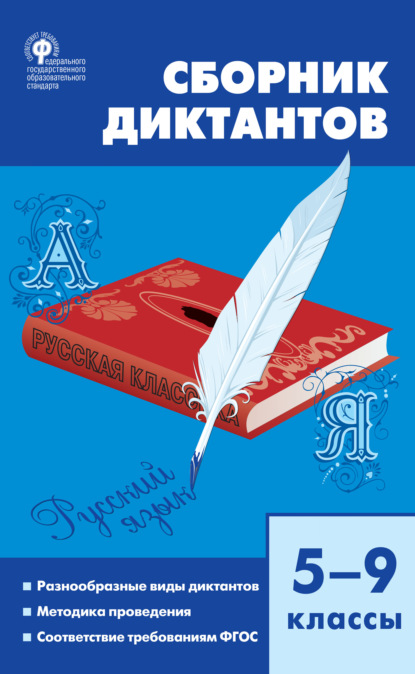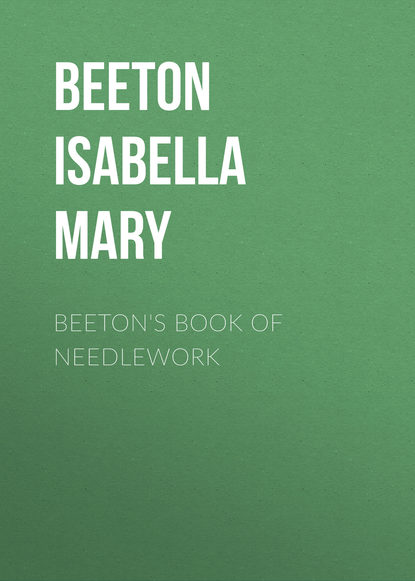По всем вопросам обращайтесь на: info@litportal.ru
(©) 2003-2024.
✖
Beeton's Book of Needlework
Автор
Год написания книги
2018
Настройки чтения
Размер шрифта
Высота строк
Поля
Materials: Net, fine muslin; Messrs. Walter Evans and Co.'s embroidery cotton No. 16.
The pattern must be traced on the muslin, which should be tacked on the net. The outline of the design must be traced with very small stitches, and worked in overcast stitches, as are also the veinings; the dots are worked in raised satin stitch; the border is embroidered with satin stitch flowers and scallop button-hole stitch. To work appliqué on net, see No. 117 (#x4_x_4_i84) of Embroidery Instructions.
148.–Wreath for centre of Pincushion or Toilet Mat.
Materials for Pincushion: Jaconet muslin; Messrs. Walter Evans and Co.'s embroidery cotton No. 16. For toilet mat: White piqué; cotton No. 12.
The leaves and flowers are worked in satin stitch; the eyelet-holes and stems in overcast stitch.
149.–Corner for Handkerchief In Point Russe.
Materials: French cambric, fine China black sewing-silk, or filoselle.
Point Russe stitch is made by a succession of back stitches. These stitches carefully follow every line of the design, and are worked in black China sewing-silk or filoselle. The pattern should be repeated at each corner of the handkerchief.
150 to 152.–Borders and Insertions.–White Embroidery.
Materials: Lawn; Messrs. Walter Evans and Co.'s embroidery cotton No. 30, and Mecklenburg thread No. 50; fine black sewing-silk.
For the border No. 150, trace first the outlines of the scallop, then draw the threads which are to form the wheel in each scallop (take for this fine Mecklenburg thread, for the rest embroidery cotton), fasten them at the places where they cross each other, and work at these places small and large spots in satin stitch. Then work the scallops in button-hole stitch; edge each larger spot with button-hole stitch all round, and make a row of button-hole stitches for the upper edge of the border, and above this a row of herring-bone stitches. The material is cut away underneath the wheels.
The corner borders, illustrations 151 and 152, are worked in point Russe, chain and satin stitch, with fine black sewing silk.
153.–Muslin Cravat.
Materials: Muslin; Messrs. Walter Evans and Co.'s embroidery cotton No. 50; No. 40 for the edges.
This cravat is worked on fine muslin, embroidered upon both ends in raised satin stitch; the scalloped edge is worked in button-hole stitch; the bouquet in the centre is worked in appliqué satin stitch–that is, the leaves of the rose and the foliage are worked separately on muslin; they are then cut out and worked in appliqué (see Nos. 113 (#x4_x_4_i78) and 116 (#x4_x_4_i83), Embroidery Instructions) upon the cravat, as seen in the illustration.
154.–Sandwich Case.
Materials: Strip of grey kid; strip of oil silk; 1 skein black silk; 1 skein red purse silk; 1 hank steel beads; steel button.
This case will be found very useful on the occasion of a journey or picnic, as it can be carried in the pocket without any inconvenience.
The case is made of a strip of grey kid, scalloped out at the edges. The words "Bon appetit," or "Good appetite," at will, are worked over it in overcast with black purse silk and steel beads, the scroll pattern in chain stitch with red silk. The back and front of the case are formed of the same strip, which is lined with oilskin, and to which narrow side-pieces are added to form the pocket. These pieces are lined and scalloped out in the same way as the back and front, and then the scallops of both sides are joined together, and worked round in button-hole stitch with purse silk.
The case is fastened down with a steel button.
If another colour is preferred, the sandwich case can be made of brown kid. The scroll pattern should then be worked in rich blue purse silk, and gold beads used for the letters, which should be embroidered as before in black silk. The edge may be worked in double overcast stitch in blue or black silk. A gold button must replace the steel when this alteration of colour is made.
155.–Insertion.
Materials: Muslin; Messrs. Walter Evans and Co.'s embroidery cotton No. 16.
This insertion is worked in raised satin stitch between two rows of hem-stitching; a small eyelet-hole is worked in the centre of each flower.
156.–Cravat End in Raised Embroidery.
Materials: Messrs. Walter Evans and Co.'s. embroidery cotton Nos. 50 and 16.
This pattern is a muslin cravat 32 inches long. The greater part of the embroidered ends is worked in satin stitch; the leaves in the bouquet of the centre are worked in raised embroidery. (See Nos. 113 (#x4_x_4_i78) and 116 (#x4_x_4_i83), Embroidery Instructions.)
The dotted lines are raised by taking four threads of the muslin on the needle, draw it half out, wind the cotton twice round the point, holding it tightly under the thumb, draw the needle out and insert it at the place where the stitch was begun, and draw it out where the next stitch is to be worked.
157.–Lady's Purse.
Materials: Russia leather; blue silk; black purse silk; blue silk soutache; fine gold braid; and gold thread.
This purse is embroidered upon Russia leather; an oval-shaped medallion is cut out in the centre; a piece of blue silk is gummed on under the leather so as to show within the oval; both leather and silk are then lined with calico and stretched upon a small embroidery frame. The front and back of the purse are made all of one piece, the centre of which is the bottom; after the embroidery is completed a piece of leather is added on each side to give the necessary fullness. Four flowrets are worked over the blue silk, with black purse silk, in raised satin stitch, with a dot in gold thread for the centre. The stems are black and the leaflets gold. The inner border round the oval medallion is worked in gold braid, and the outer one in blue soutache. The network upon the leather is formed of threads of black purse silk, fastened at every crossing with a stitch of gold thread; the outer border round this network is formed entirely of gold braid. On the opposite side of the purse initials may be worked in black and gold, over the blue silk oval medallion.
The purse is lined with brown watered silk, and mounted with a clasp of gilt steel.
158.–Table-Napkin Ring.
Materials: Crimson cashmere; toile cirée; 1 reel each of white, black, green, blue, and yellow Chinese silk.
Stretch a strip of cashmere of a bright shade of crimson over a piece of toile cirée, and work the pattern over it in point Russe with fine silk. The outer borders have white and black outlines, and leaflets of green silk. The stars have black and blue outlines, a yellow cross and dots. The figure between the stars is black and yellow.
159 and 160.–Knife Basket.
Materials: Grey American cloth; red cloth; black jet beads and bugles; red worsted braid, three-quarters of an inch wide; some strong wire; a cigar-box.
This basket is meant for holding dessert knives. It consists of a common cigar-box nine inches and two-fifths long, five inches and four-fifths wide, and two inches and one-fifth high, covered inside and out with grey American cloth, which is ornamented with embroidery worked in appliqué. The seams are made in overcast stitch. The feet consist of four pieces of strong wire three inches and two-fifths long. These pieces of wire are first covered with wool, and then with jet beads; they are then bent into loops, and fastened on at the bottom of the box by means of holes bored into it for that purpose. The feet must be fastened before covering the inside of the box. The inside of the basket is ornamented with an embroidered pattern in appliqué, which must also be worked before covering the box. The leaves are made of red cloth, the stems and veinings of black bugles. No. 160 shows the pattern in full size; the flowers and leaves are edged with light grey purse silk, over which small stitches in black silk are fastened at regular intervals. Inside the box fasten a deal board covered on both sides with American cloth, so as to divide the basket into two compartments, and fasten on to this board a handle consisting of a piece of wire seven inches long, wound round with beads. The basket is ornamented with ruches of red worsted braid; between two box pleats of the ruche a black bugle is fastened.
161.–Satin Stitch Embroidery.
Materials: Purse silk of two colours, in 4 shades of green and 4 shades of red or magenta for the flowers, gold twist.
This branch is embroidered with purse silk of the natural colours of the flowers and leaves, or in different shades of one colour, on silk canvas. Fuchsia blossoms are here designed, and should be worked in raised embroidery; the stamens to be worked in gold twist.
162.–Acacia Spray in Raised Satin Stitch Embroidery.
Materials: Four shades of green purse silk for the leaves; 1 skein of brown silk; 3 shades of white or gold silk for the flowers.
This spray of acacia is worked in raised satin stitch embroidery; the flowers should be carefully shaded, and the veinings should be worked before the leaves are embroidered. The flowers may be worked gold colour, or imitate the white acacia blossom.
163 and 164.–Tobacco Pouch.
Materials: Fine crimson cloth; bits of coloured and white cloth for the pattern; purse silk of various colours; white kid; brass rings; gimp cord; and silk tassels.
This pouch is cut in four pieces, two of which are given in full size; the two others must be worked after the same patterns. These patterns represent the attributes of a lover of tobacco; they are cut out of cloth and worked in appliqué over crimson cloth.
In No. 163 the outer chain stitch border is green. The knot from which the different articles are suspended is black, the cigar-case yellow in cloth appliqué, the cigars brown in satin stitch. The case is crossed by two rows of chain stitch in blue silk, and edged all round with button-hole stitch, also blue. The two pipes are of white cloth, edged round with yellow silk; the shade is imitated by long stitches of grey silk. The upper part of the pouch is of blue cloth, with a white silk edging and yellow dots; the under part of brown cloth with a black edging and a pattern worked in chain stitch with white; the three tassels are embroidered with black and yellow silk.
In No. 164 the outer border is yellow, the knots black, the small pattern at the top is of blue cloth edged with yellow; the pipes of white cloth edged with blue and shaded with grey. The bundle of cigars is of brown cloth, shaded with black silk stitches, and fastened on with double rows of chain stitch in yellow silk. The cigar-case is of light green cloth, edged with white; the Grecian pattern and dots are embroidered over it with white silk also.
To make up the pouch, cut out the four pieces and join them together by seams, which are hidden under yellow soutache; cut out also and join in the same way four pieces of white kid for the lining, and fasten it on to the crimson cloth at the top only. Sew small brass rings round the top, and pass a double piece of crimson silk cord through them. Add silk tassels of various colours at the bottom of the pouch, and at each of its four corners.





